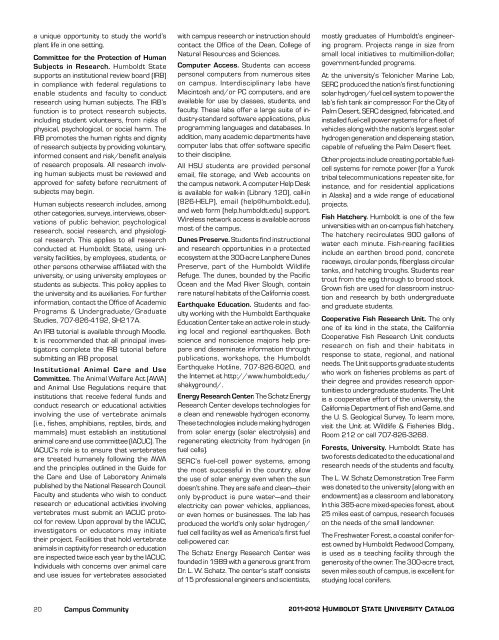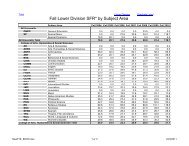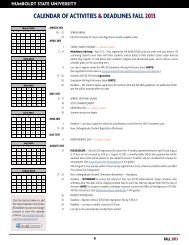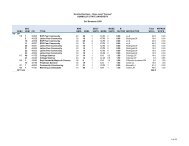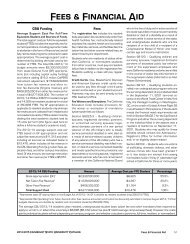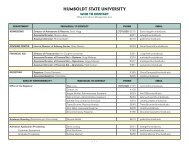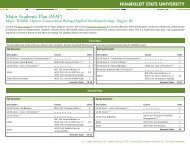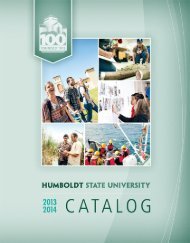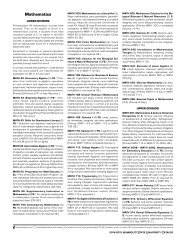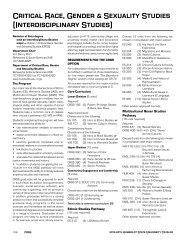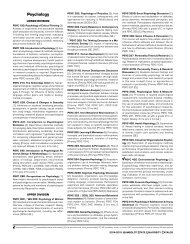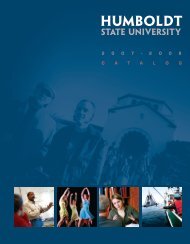2011-12 Academic Year - Bad Request - Humboldt State University
2011-12 Academic Year - Bad Request - Humboldt State University
2011-12 Academic Year - Bad Request - Humboldt State University
You also want an ePaper? Increase the reach of your titles
YUMPU automatically turns print PDFs into web optimized ePapers that Google loves.
a unique opportunity to study the world’s<br />
plant life in one setting.<br />
Committee for the Protection of Human<br />
Subjects in Research. <strong>Humboldt</strong> <strong>State</strong><br />
supports an institutional review board (IRB)<br />
in compliance with federal regulations to<br />
enable students and faculty to conduct<br />
research using human subjects. The IRB’s<br />
function is to protect research subjects,<br />
including student volunteers, from risks of<br />
physical, psychological, or social harm. The<br />
IRB promotes the human rights and dignity<br />
of research subjects by providing voluntary,<br />
informed consent and risk/benefit analysis<br />
of research proposals. All research involving<br />
human subjects must be reviewed and<br />
approved for safety before recruitment of<br />
subjects may begin.<br />
Human subjects research includes, among<br />
other categories, surveys, interviews, observations<br />
of public behavior, psychological<br />
research, social research, and physiological<br />
research. This applies to all research<br />
conducted at <strong>Humboldt</strong> <strong>State</strong>, using university<br />
facilities, by employees, students, or<br />
other persons otherwise affiliated with the<br />
university, or using university employees or<br />
students as subjects. This policy applies to<br />
the university and its auxiliaries. For further<br />
information, contact the Office of <strong>Academic</strong><br />
Programs & Undergraduate/Graduate<br />
Studies, 707-826-4192, SH217A.<br />
An IRB tutorial is available through Moodle.<br />
It is recommended that all principal investigators<br />
complete the IRB tutorial before<br />
submitting an IRB proposal.<br />
Institutional Animal Care and Use<br />
Committee. The Animal Welfare Act (AWA)<br />
and Animal Use Regulations require that<br />
institutions that receive federal funds and<br />
conduct research or educational activities<br />
involving the use of vertebrate animals<br />
(i.e., fishes, amphibians, reptiles, birds, and<br />
mammals) must establish an institutional<br />
animal care and use committee (IACUC). The<br />
IACUC’s role is to ensure that vertebrates<br />
are treated humanely following the AWA<br />
and the principles outlined in the Guide for<br />
the Care and Use of Laboratory Animals<br />
published by the National Research Council.<br />
Faculty and students who wish to conduct<br />
research or educational activities involving<br />
vertebrates must submit an IACUC protocol<br />
for review. Upon approval by the IACUC,<br />
investigators or educators may initiate<br />
their project. Facilities that hold vertebrate<br />
animals in captivity for research or education<br />
are inspected twice each year by the IACUC.<br />
Individuals with concerns over animal care<br />
and use issues for vertebrates associated<br />
with campus research or instruction should<br />
contact the Office of the Dean, College of<br />
Natural Resources and Sciences.<br />
Computer Access. Students can access<br />
personal computers from numerous sites<br />
on campus. Interdisciplinary labs have<br />
Macintosh and/or PC computers, and are<br />
available for use by classes, students, and<br />
faculty. These labs offer a large suite of industry-standard<br />
software applications, plus<br />
programming languages and databases. In<br />
addition, many academic departments have<br />
computer labs that offer software specific<br />
to their discipline.<br />
All HSU students are provided personal<br />
email, file storage, and Web accounts on<br />
the campus network. A computer Help Desk<br />
is available for walk-in (Library <strong>12</strong>0), call-in<br />
(826-HELP), email (help@humboldt.edu),<br />
and web form (help.humboldt.edu) support.<br />
Wireless network access is available across<br />
most of the campus.<br />
Dunes Preserve. Students find instructional<br />
and research opportunities in a protected<br />
ecosystem at the 300-acre Lanphere Dunes<br />
Preserve, part of the <strong>Humboldt</strong> Wildlife<br />
Refuge. The dunes, bounded by the Pacific<br />
Ocean and the Mad River Slough, contain<br />
rare natural habitats of the California coast.<br />
Earthquake Education. Students and faculty<br />
working with the <strong>Humboldt</strong> Earthquake<br />
Education Center take an active role in studying<br />
local and regional earthquakes. Both<br />
science and nonscience majors help prepare<br />
and disseminate information through<br />
publications, workshops, the <strong>Humboldt</strong><br />
Earthquake Hotline, 707-826-6020, and<br />
the Internet at http://www.humboldt.edu/<br />
shakyground/.<br />
Energy Research Center. The Schatz Energy<br />
Research Center develops technologies for<br />
a clean and renewable hydrogen economy.<br />
These technologies include making hydrogen<br />
from solar energy (solar electrolysis) and<br />
regenerating electricity from hydrogen (in<br />
fuel cells).<br />
SERC’s fuel-cell power systems, among<br />
the most successful in the country, allow<br />
the use of solar energy even when the sun<br />
doesn’t shine. They are safe and clean—their<br />
only by-product is pure water—and their<br />
electricity can power vehicles, appliances,<br />
or even homes or businesses. The lab has<br />
produced the world’s only solar hydrogen/<br />
fuel cell facility as well as America’s first fuel<br />
cell-powered car.<br />
The Schatz Energy Research Center was<br />
founded in 1989 with a generous grant from<br />
Dr. L. W. Schatz. The center’s staff consists<br />
of 15 professional engineers and scientists,<br />
mostly graduates of <strong>Humboldt</strong>’s engineering<br />
program. Projects range in size from<br />
small local initiatives to multimillion-dollar,<br />
government-funded programs.<br />
At the university’s Telonicher Marine Lab,<br />
SERC produced the nation’s first functioning<br />
solar hydrogen/fuel cell system to power the<br />
lab’s fish tank air compressor. For the City of<br />
Palm Desert, SERC designed, fabricated, and<br />
installed fuel-cell power systems for a fleet of<br />
vehicles along with the nation’s largest solar<br />
hydrogen generation and dispensing station,<br />
capable of refueling the Palm Desert fleet.<br />
Other projects include creating portable fuelcell<br />
systems for remote power (for a Yurok<br />
tribal telecommunications repeater site, for<br />
instance, and for residential applications<br />
in Alaska) and a wide range of educational<br />
proj ects.<br />
Fish Hatchery. <strong>Humboldt</strong> is one of the few<br />
universities with an on-campus fish hatchery.<br />
The hatchery recirculates 900 gallons of<br />
water each minute. Fish-rearing facilities<br />
include an earthen brood pond, concrete<br />
raceways, circular ponds, fiberglass circular<br />
tanks, and hatching troughs. Students rear<br />
trout from the egg through to brood stock.<br />
Grown fish are used for classroom instruction<br />
and research by both undergraduate<br />
and graduate students.<br />
Cooperative Fish Research Unit. The only<br />
one of its kind in the state, the California<br />
Cooperative Fish Research Unit conducts<br />
research on fish and their habitats in<br />
response to state, regional, and national<br />
needs. The Unit supports graduate students<br />
who work on fisheries problems as part of<br />
their degree and provides research opportunities<br />
to undergraduate students. The Unit<br />
is a cooperative effort of the university, the<br />
California Department of Fish and Game, and<br />
the U. S. Geological Survey. To learn more,<br />
visit the Unit at Wildlife & Fisheries Bldg.,<br />
Room 2<strong>12</strong> or call 707-826-3268.<br />
Forests, <strong>University</strong>. <strong>Humboldt</strong> <strong>State</strong> has<br />
two forests dedicated to the educational and<br />
research needs of the students and faculty.<br />
The L. W. Schatz Demonstration Tree Farm<br />
was donated to the university (along with an<br />
endowment) as a classroom and laboratory.<br />
In this 385-acre mixed-species forest, about<br />
25 miles east of campus, research focuses<br />
on the needs of the small landowner.<br />
The Freshwater Forest, a coastal conifer forest<br />
owned by <strong>Humboldt</strong> Redwood Company,<br />
is used as a teaching facility through the<br />
generosity of the owner. The 300-acre tract,<br />
seven miles south of campus, is excellent for<br />
studying local conifers.<br />
20 Campus Community<br />
<strong>2011</strong>-20<strong>12</strong> <strong>Humboldt</strong> <strong>State</strong> <strong>University</strong> Catalog


